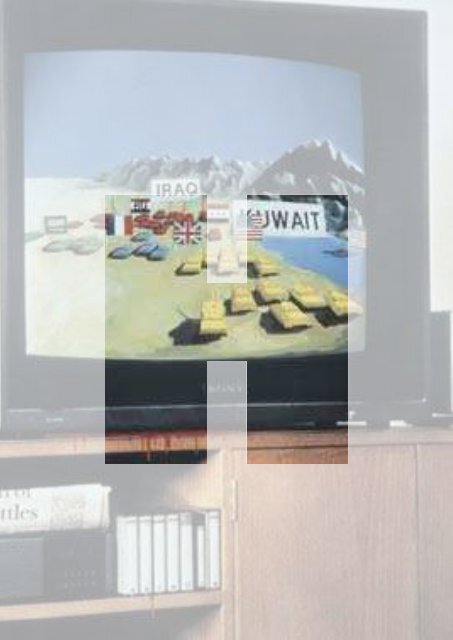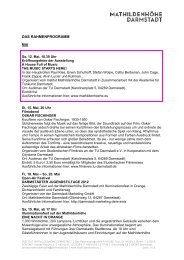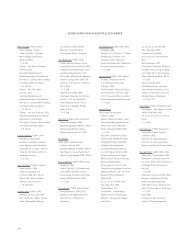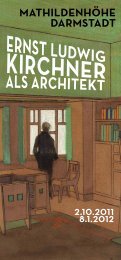Peggy Ahwesh Oliver van den Berg Wafaa Bilal ... - Mathildenhöhe
Peggy Ahwesh Oliver van den Berg Wafaa Bilal ... - Mathildenhöhe
Peggy Ahwesh Oliver van den Berg Wafaa Bilal ... - Mathildenhöhe
Erfolgreiche ePaper selbst erstellen
Machen Sie aus Ihren PDF Publikationen ein blätterbares Flipbook mit unserer einzigartigen Google optimierten e-Paper Software.
= Hairline Cross => Fa<strong>den</strong>kreuz<br />
In 1991, there were two kinds of shots from<br />
the war of the Coalition Forces against Iraq<br />
that were something new, that belonged to<br />
a visual category of their own.<br />
The first shot shows a section of land,<br />
taken from a camera in a helicopter, an airplane,<br />
or in a drone—the name for an unmanned<br />
light aircraft used for aerial reconnaissance.<br />
Crossing the center of the image<br />
are the lines marking the target. The projectile<br />
hits, the detonation overloads the contrast<br />
range, the automatic fade counteracts<br />
it; the image breaks off.<br />
The second shot comes from a camera<br />
installed in the head of a projectile. This<br />
camera crashes into its target—and here as<br />
well, of course, the image breaks off.<br />
Since 1920 in the USA, shots filmed from<br />
a position normally not taken by a person<br />
have been called phantom shots; shots, for<br />
instance, from a camera positioned under<br />
a train track. Images from the point of view<br />
of a person are called subjectives. We can<br />
therefore regard the shot from the perspective<br />
of a bomb as a phantom subjective.<br />
The shots taken from a camera that<br />
crashes into its target, that is, from a suicide<br />
camera, cling to the memory. They<br />
were new and added something to the<br />
image that we may have heard about since<br />
the cruise missiles in the nineteen-eigh-<br />
ties, but didn’t know anything specific about.<br />
They appeared together with the word “intelligent<br />
weapons,” connecting a rather glib<br />
idea of intelligence together with an equally<br />
glib idea of subjectivity.<br />
Animations as well, whether produced<br />
on a drawing board or on a computer, frequently<br />
used perspectives that were difficult<br />
or even impossible for a camera to take: for<br />
instance that of a bullet flying toward its target.<br />
Drawn animated films therefore established<br />
a predominance over the film-photographic<br />
shot. Animated films therefore became<br />
the means to make technological<br />
functions dynamically representable: thermal<br />
processes, biological functions, crosssections<br />
of apparatuses.<br />
In 1991, it was often stated that images of<br />
approaching targets and detonations taken<br />
from surveillance cameras made war look<br />
“like a computer game.” What was meant<br />
was that war looked like a children’s game.<br />
The difference between the serious and the<br />
playful, child and adult has in the intervening<br />
period become meaningless in this respect.<br />
Since then, soldiers have been practicing for<br />
war in visual worlds that the military has taken<br />
over from the game industry and adapted<br />
for their own purposes. (The U.S. military<br />
having previously helped the games industry<br />
generate images of certain theaters of war<br />
such as Afghanistan or Iraq).<br />
Since then, computer animation has become<br />
standard. If twenty or thirty years<br />
ago they looked as if they were trying to imitate<br />
film, today they abound with self-assurance.<br />
Animation comes from the computer<br />
and computer technology is so well established<br />
as the primary medium that even a<br />
badly produced image from a computer is<br />
now considered superior to a decent one<br />
from a photo or film camera. The computer<br />
has become the standard, just as the industrial<br />
machine did a hundred years ago.<br />
If a computer image leaves out a detail that<br />
film-photography reproduces, this is no longer<br />
considered a deficiency, but instead an<br />
ideal representation. Today, computer animation<br />
is like a reproach to a filmed recording<br />
for reproducing superfluous details, just<br />
as an industrial product is a critique of the<br />
irregularity of a hand-made object. The fact<br />
that in computer images framing and camera<br />
position can be reconfigured afterward,<br />
that a figure in the image can react to something<br />
happening outside the image (that they<br />
can fall to the ground or shoot back when<br />
they’re shot at), all of this more than compensates<br />
for the loss of a verifiable relation<br />
to the factual.<br />
In these new images from Iraq in 1991,<br />
those with the hairline crosses in the center,<br />
there are hardly ever any humans to be<br />
seen. The battlefield is shown as deserted.<br />
And if we look at a series of such images,<br />
one could imagine that they are of a war,<br />
which rages on even after people have disappeared<br />
from the Earth. The agenda of war<br />
is executed by autonomous war machines.<br />
The operational images of approaching<br />
targets and detonation usually show mil-<br />
95









